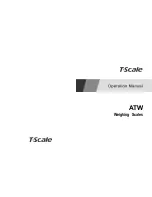
At the same time that the current is injected, a second set of multiplexers connects a differential amplifier across the same
body impedance in order to measure the voltage drop created by the injected current:
Where Z and θ are the module and phase of the impedance at
, respectively.
The output of the amplifier is routed to a pair of switches that implement the demodulation at the same frequency as the
excitation current source in order to drive the control of those switches. This circuit performs a full-wave rectification of the
differential amplifier output and a low-pass filter at its output, recovers the dc level, and finally routes it to the same 16-bit
digitizer used in the weight-scale chain.
∫
Ultimately, the dc output is proportional to the module of the impedance. The proportionality factor can be obtained through
calibration with the four external impedances. Although, with one single frequency or measurement, only the module of the
impedance can be obtained; two different frequencies could be used to obtain both the real and the imaginary parts.
2.2.2.2 I/Q Demodulation
Figure 6 BCM in I/Q Demodulator Mode
As explained previously, the portion of the circuit injecting the current into the body is the same for both configurations.
Therefore, the circuit is the same in Figure 5 and Figure 6. The difference between them is that an I/Q demodulator is used in
this second approach, as shown in Figure 6.
As with the case of the RMS detector, a differential amplifier measures the voltage drop across the impedance:






























